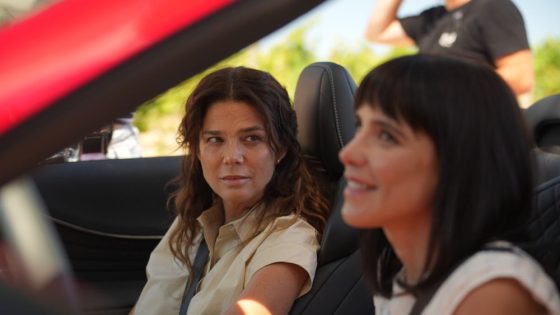NEWTON, Iowa – When Humpy Wheeler was the president and general manager at Charlotte Motor Speedway, he used to call the upper lanes of a race track, “Where angels fear to tread,” because of the collection of rubber pellets from the tires, known as “marbles,” would accumulate.
IndyCar drivers discovered what the former NASCAR track executive was referring to in Friday’s 90-minute practice session for the Hy-Vee IndyCar Race Weekend at Iowa Speedway.
IndyCar officials decided to have a high-line practice prior to the regular 90-minute practice session to help “rubber in” the upper groove. It was two 15-minute sessions split into groups.
That is a tactic that has worked in the past at other ovals on the schedule, and it seemed to work well on Friday as the 27 drivers completed 1,053 combined laps without an incident.
But when the regular 90-minute session began and the IndyCar drivers used the newer pavement that had more grip, the Firestone tires began to degrade, a natural process on racing series.
IndyCar had each car use lower downforce to help control the tire deg, but it wasn’t long before the marbles accumulated on the upper lanes, creating a slick surface.
By the time the 90-minute session concluded, a combined 2,256 laps had been turned and even the best drivers in the series had issues going high on the track.
That included the fastest driver of the session, Team Penske’s Scott McLaughlin.
He had already posted the fastest lap of the session at 185.891 miles per hour in the No. 3 XPEL Chevrolet for Team Penske.
But with 12 minutes left before the end of practice, McLaughlin spun in Turn 4 after going high. He kept it off the wall, but it foreshadowed what may come in Saturday night’s Hy-Vee Homefront 250 presented by Instacart.
“It was just pure driver problem,” McLaughlin said. “I was trying to drive it up the fence a little bit, and try the outside line, but there were a lot of marbles up there.
“It’s a shame, but I don’t think you can go up there. It’s going to be tough.”
Later in the conversation, McLaughlin elaborated on how the different track surface from the new pavement compared to the old pavement affects the cars handling.
“From the start, the car was pretty good off the truck and we had to make some changes off the downforce levels, but, overall, the car was pretty solid,” McLaughlin said. “I was testing a couple of things in Turn 4 and got caught up in the marbles. That’s going to be tough in the race.”
“There’s some tire deg, but not as much as we’ve seen in the past,” the Team Penske driver said. “I think that’s more track specific than tires or whatnot.
“I think it sucks a little bit that the repave is not great for us, but it is what it is. Everyone’s got the same track to deal with, so see how we go.”
Most of the incidents were fairly harmless spins, except for the first of the day involving Marcus Ericsson of Andretti Global.
Just 20 minutes in the session, Ericsson’s No. 28 Honda approached the entry of Turn 3 and the car swapped ends and slammed into the outside wall. He was taken to the infield care center where he was examined and released.
“It did, very early, it snapped around,” Ericsson said. “The car felt great. It was super comfortable. Just really frustrating.
“This is it for practice. The other car has only run a couple of laps. I feel bad for the guys, but anything can happen in these cars.”
With 25 minutes left in the session, Katherine Legge in the No. 51 E.L.F. Honda tried to avoid Christian Lundgaard’s slower car. She got into the gray area of Turn 3 and immediately lost traction and spun. Legge was able to avoid contact, but the yellow light was turned on for caution.
With 7 minutes left in the session, Agustin Canapino spun in Turn 2 and washed up the track, nearly into the path of teammate Romain Grosjean, who got on the brakes to avoid a crash.
During the caution, Scott Dixon was heading into his pit box when he saw the Arrow McLaren “papaya” and pulled into Canapino’s path as he was entering his pit area. The two cars collided on pit lane, but Dixon was able to eventually get the No. 9 PNC Bank Honda serviced and return to the track.
“I’m really happy with the day,” Canapino said. “We were really fast. Unfortunately, I made a mistake on the track. I think we have a good chance to do well in the race.
“Will Power was slowing a lot. I don’t know what happened there. I don’t know what Scott Dixon was doing. I don’t know. He was confused or something.”
Dixon admitted he got the two Juncos Hollinger cars confused.
“We pitted behind their sister car, and I thought it was Romain Grosjean’s car,” Dixon said. “Luckily, we were slow speed there and had a little touch.
“The car had decent speed and hopefully, we’ll be in a good spot.”
McLaughlin’s fastest speed was 185.891 miles per hour in the No. 3 Team Penske Chevrolet followed by Alex Palou’s No. 10 Honda for Chip Ganassi Racing at 184.536 mph.
Last week’s Mid-Ohio winner, Pato O’Ward, was third at 184.154 mph in the No. 5 Arrow McLaren Chevrolet followed by David Malukas in the No. 66 Arrow McLaren Honda for Meyer Shank Racing at 184.112 mph.
Alexander Rossi of Arrow McLaren rounded out the top five at 183.784 mph in the No. 7 Chevrolet.
Iowa Speedway has traditionally been one of IndyCar’s best tracks, and probably it’s best short oval (tracks that measure less than 1.5 miles in length).
It has provided some of the best racing in the series because it is high-speed racing in close quarters.
But the partial repave has the potential to cause issues in the two races that make up the Hy-Vee IndyCar Race Weekend at Iowa Speedway.

Dixon is making his 20th career start at Iowa Speedway and has competed in every IndyCar Series race at the short oval that was originally designed by NASCAR Hall of Fame driver Rusty Wallace.
“It has definitely changed,” Dixon said of Iowa Speedway. “From the first few races we had here, you just followed the white line, and it was a pack race. It was kind of chaotic for a short track.
“We went through a good period for the last 10 years whether it’s multi-lane, high deg, and one of the best short track races that we have had.
“With the repave, partial repave, that they’ve done, it’s has taken away a lot of race ability that we had. Maybe it’s better for other categories.”
The hard reality is this: NASCAR owns Iowa Speedway. Penske Entertainment and IndyCar lease Iowa Speedway to stage one of the best racing weekends of the year, the Hy-Vee IndyCar Race Weekend at Iowa Speedway that combines two full races with four concerts featuring A-list entertainers Luke Combs and Eric Church on Saturday and Kelsea Ballerini and Post Malone on Sunday.
After seeing IndyCar turn Iowa Speedway into a “destination event,” NASCAR scheduled the NASCAR Cup Series Iowa Corn 350 for June 15. It was the first time a NASCAR Cup Series race was ever held at Iowa Speedway.
To improve that race, NASCAR made changes to the track that helped its cars but has the potential to have a detrimental impact on the IndyCar races this weekend.
“Yeah, I miss last year’s track,” Dixon said. “I think drivers refer to it as character. It had a lot of character. It had a lot of bumps. It was definitely hard work.
“Qualifying was very tough. Then obviously you had the use of two, three, four lanes in the race, especially on restarts and things like that.
“We’ll see. I hope it gets back to that. Whether it’s this weekend, it’s going to be tough to get that second lane to come in.
“Yeah, it’s definitely evolved over the years.”
IndyCar drivers thought the high-line practice was positive, but the longer the regular practice lasted, the grip level from top to bottom began to shrink as none of the drivers were daring enough to use it.
That created the problem the IndyCar drivers will have to manage for the rest of the weekend.
“You are on the new pavement all the way, but when I first ran the high-line practice I thought it was really good, but the bottom lane is the preferred lane and after 40 or 50 laps, the lane gets smaller and smaller and smaller,” McLaughlin explained.
Saturday’s schedule includes a unique qualification format that begins at 3:45 p.m. ET. The first lap determines the starting position for a driver in Saturday night’s race and the second lap sets the field for Sunday’s Hy-Vee One Step 250 presented by Gatorade.
Qualifications will air on Peacock.
NBC goes on the air for the race at 8 p.m. ET with the start-engine command at 8:01. The green flag waves to start the race at 8:06 p.m.
It’s a quick turnaround for Sunday with NBC going on the air at noon Eastern and the race beginning at 12:30 p.m. ET.
“It’s certainly a tough schedule going from a night race into a late morning (race),” McLaughlin continued. “The teams have been prepared for it for a long time.
“Ultimately, you never want to crash. Obviously, if you do, you have a shunt on Saturday. It puts a little bit of pressure on them. Every team on pit lane has some of the best people in the world. I’m sure it’s easy to put a car going. You don’t want to do it. It’s not easy, but it is what it is.
“But yeah, the commitment is there, and they’re ready to go if need be.”
Source Agencies



